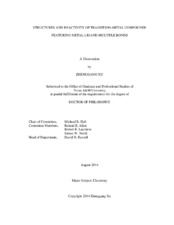| dc.contributor.advisor | Hall, Michael B. | |
| dc.creator | Xu, Zhenggang | |
| dc.date.accessioned | 2015-02-05T17:27:07Z | |
| dc.date.available | 2016-08-01T05:30:20Z | |
| dc.date.created | 2014-08 | |
| dc.date.issued | 2014-07-25 | |
| dc.date.submitted | August 2014 | |
| dc.identifier.uri | https://hdl.handle.net/1969.1/153482 | |
| dc.description.abstract | This dissertation presents the results from density functional theory (DFT) calculations on three major projects I have been working on over the past several years. The first system is focused on the structure and reactivity of a novel osmium silylyne compounds featuring an Os≡Si triple bond. NMR simulation confirmed the existence of this compounds and bonding analysis like NBO and ETS-NOCV proved its triple bond character. The structures of the [2+2] cyclo-addition product from silylyne and other small molecules (PhC≡CPh and P≡C^(t)Bu) were also determined from possible isomers by energetic results and NMR simulations. The cycloaddition reactions were found to be under kinetic control and steric effects should be a major reason for that. Furthermore, the geometric and electronic structures of the osmium silylyne analogues (M≡E, M = Ru and Os; E = Si, Ge and Sn) are studied computationally and their similarities and distinctions are discussed.
Both the second and third systems are related to the formation of transition metal imido compound (M=NR). In the second system a cationic oxorhenium(V) complex reacts with a series of arylazides (N_(3)Ar) to give cationic cis-rhenium(VII) oxo imido complexes. Inductive effect is found in the reaction rates but it leads to different trends for electron-donating and electron-withdrawing substituted phenyl azides. Computations found all the substituted phenyl imido products are formed through the same pathway. The reason for the different trend is due to the competitions between two major energy barriers along the reaction pathway. For the electron-withdrawing substituents, N_(2) extrusion is rate determining, while for the electron-donating substituents, the rate-determining step becomes the initial attack of the azide. The barriers for these two steps are inverted in their order with respect to the Hammett σ values; thus, the Hammett plot appears with a break in slope.
In the third system a series of vanadium (III) terminal organoazides were converted to vanadium (V) imido compounds and small quantities of diazenes were found formed in the reactions. Computational studies were conducted to examine serveral possible pathways and a mechanism in which nitrene radicals released from metal-azide decompositions is supported based on two reasons: 1) The two-electron reduction on vanadium center during decomposition of azide generates two fragments both in their ground states (triplet states), which might drag the activation barrier down; 2) This conversion is spin-allowed since vanadium center and nitrene nitrogen are antiferromagnetically coupled in transition state. The ligand simplification study indicates that the bulky mesityl groups on the supporting ligand prevents the reactions from going through the direct N_(2) extrusion pathway. | en |
| dc.format.mimetype | application/pdf | |
| dc.language.iso | en | |
| dc.subject | Structure | en |
| dc.subject | Reactivity | en |
| dc.subject | Transition Metal Compound | en |
| dc.subject | Metal-ligand Multiple Bond | en |
| dc.title | Structures and Reactivity of Transition-Metal Compounds Featuring Metal-Ligand Multiple Bonds | en |
| dc.type | Thesis | en |
| thesis.degree.department | Chemistry | en |
| thesis.degree.discipline | Chemistry | en |
| thesis.degree.grantor | Texas A & M University | en |
| thesis.degree.name | Doctor of Philosophy | en |
| thesis.degree.level | Doctoral | en |
| dc.contributor.committeeMember | Allen, Roland E. | |
| dc.contributor.committeeMember | Lucchese, Robert R. | |
| dc.contributor.committeeMember | North, Simon W. | |
| dc.type.material | text | en |
| dc.date.updated | 2015-02-05T17:27:07Z | |
| local.embargo.terms | 2016-08-01 | |
| local.etdauthor.orcid | 0000-0002-8781-6867 | |


